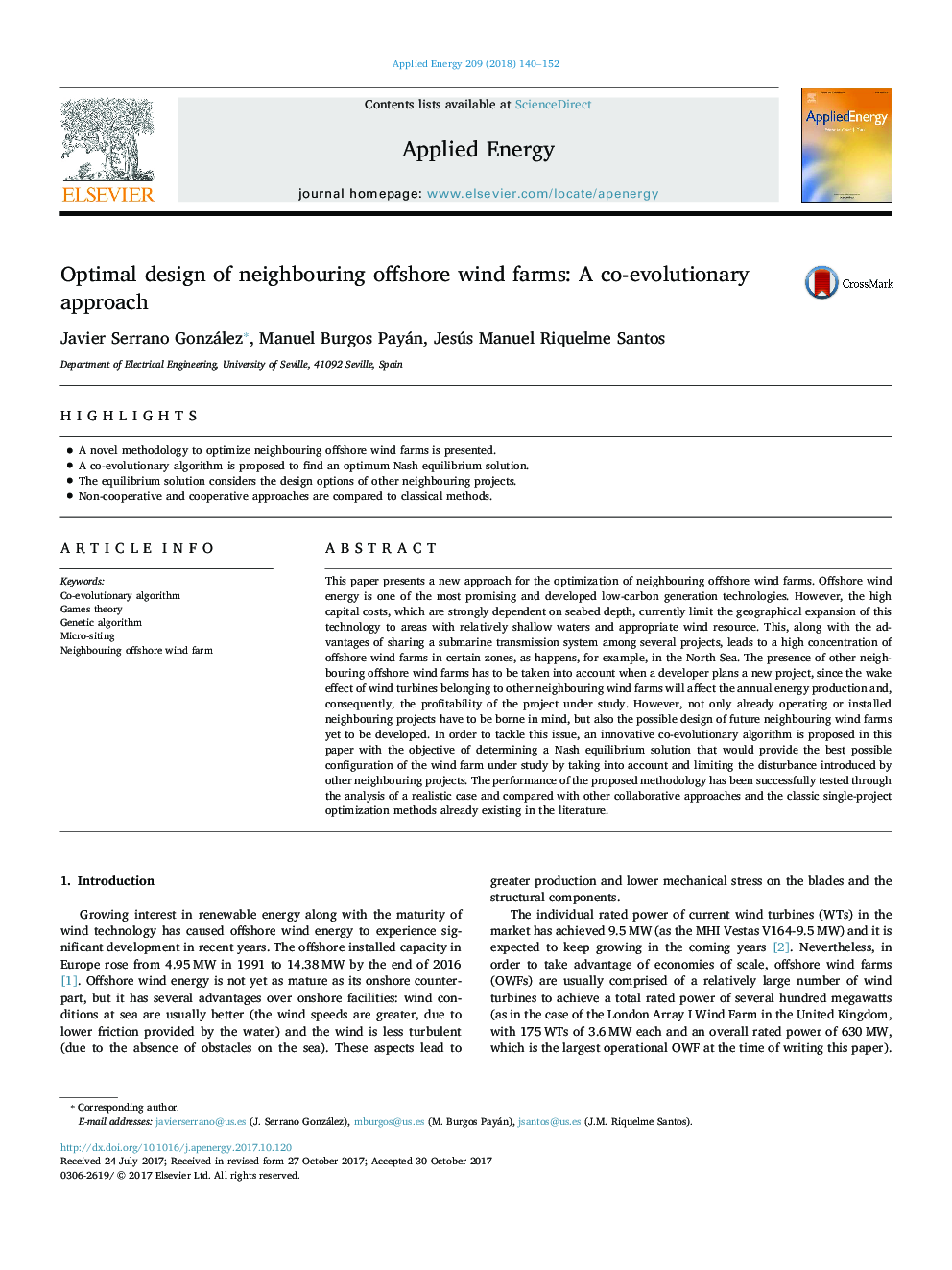| کد مقاله | کد نشریه | سال انتشار | مقاله انگلیسی | نسخه تمام متن |
|---|---|---|---|---|
| 6681525 | 1428081 | 2018 | 13 صفحه PDF | دانلود رایگان |
عنوان انگلیسی مقاله ISI
Optimal design of neighbouring offshore wind farms: A co-evolutionary approach
ترجمه فارسی عنوان
طراحی مطلوب مزارع بادی دریایی همسایه: یک رویکرد هماهنگ تکاملی
دانلود مقاله + سفارش ترجمه
دانلود مقاله ISI انگلیسی
رایگان برای ایرانیان
کلمات کلیدی
الگوریتم هماهنگ تکاملی، تئوری بازی، الگوریتم ژنتیک، محل قرارگیری میکرو، مزرعه باد همسایه،
ترجمه چکیده
این مقاله روشی جدید برای بهینه سازی مزارع بادی دریایی در کنار هم قرار می دهد. انرژی باد در دریای خزر یکی از فن آوری های نوظهور و پیشرفته تولید کم کربن است. با این حال، هزینه های بالای سرمایه، که به شدت وابسته به عمق دریا، در حال حاضر گسترش جغرافیایی این فن آوری را به مناطق با آب های نسبتا کم عمق و منابع باد مناسب محدود می کند. این، همراه با مزایای به اشتراک گذاری یک سیستم انتقال زیردریایی در میان پروژه های مختلف، منجر به غلظت بالای مزارع بادی دریایی در مناطق خاصی می شود، مثل مثال در دریای شمال. حضور دیگر مزارع بادی دریایی همسایه در زمانی که یک توسعه دهنده یک پروژه جدید را برنامه ریزی می کند، باید مورد توجه قرار گیرد، از آنجاییکه تأثیر توربین های باد که متعلق به دیگر مزارع بادی مجاور است، بر تولید سالانه انرژی و در نتیجه سودآوری پروژه تاثیر می گذارد تحت مطالعه با این حال، نه تنها در حال حاضر پروژه های همسایه در حال اجرا و یا نصب شده باید در نظر گرفته شود، بلکه طرح احتمالی مؤسسات بادی آینده همسایه هنوز توسعه یافته است. به منظور مقابله با این مسئله، یک الگوریتم هماهنگی نوآورانه ابتکاری در این مقاله با هدف تعیین راه حل تعادل نهاس ارائه شده است که بهترین تنظیم ممکن است از مزرعه باد تحت مطالعه را با در نظر گرفتن و محدود کردن اختلال ارائه شده توسط دیگر پروژه های همسایه. عملکرد روش پیشنهادی با تحلیل یک مورد واقع بینانه با موفقیت مورد آزمایش قرار گرفت و در مقایسه با سایر روشهای همکاری و روشهای بهینه سازی تک پروژه ای که در حال حاضر در ادبیات وجود دارد، مقایسه شده است.
موضوعات مرتبط
مهندسی و علوم پایه
مهندسی انرژی
مهندسی انرژی و فناوری های برق
چکیده انگلیسی
This paper presents a new approach for the optimization of neighbouring offshore wind farms. Offshore wind energy is one of the most promising and developed low-carbon generation technologies. However, the high capital costs, which are strongly dependent on seabed depth, currently limit the geographical expansion of this technology to areas with relatively shallow waters and appropriate wind resource. This, along with the advantages of sharing a submarine transmission system among several projects, leads to a high concentration of offshore wind farms in certain zones, as happens, for example, in the North Sea. The presence of other neighbouring offshore wind farms has to be taken into account when a developer plans a new project, since the wake effect of wind turbines belonging to other neighbouring wind farms will affect the annual energy production and, consequently, the profitability of the project under study. However, not only already operating or installed neighbouring projects have to be borne in mind, but also the possible design of future neighbouring wind farms yet to be developed. In order to tackle this issue, an innovative co-evolutionary algorithm is proposed in this paper with the objective of determining a Nash equilibrium solution that would provide the best possible configuration of the wind farm under study by taking into account and limiting the disturbance introduced by other neighbouring projects. The performance of the proposed methodology has been successfully tested through the analysis of a realistic case and compared with other collaborative approaches and the classic single-project optimization methods already existing in the literature.
ناشر
Database: Elsevier - ScienceDirect (ساینس دایرکت)
Journal: Applied Energy - Volume 209, 1 January 2018, Pages 140-152
Journal: Applied Energy - Volume 209, 1 January 2018, Pages 140-152
نویسندگان
Javier Serrano González, Manuel Burgos Payán, Jesús Manuel Riquelme Santos,
